Implementing Strategy and Change: International Business Strategy
VerifiedAdded on 2021/10/28
|12
|2872
|220
Essay
AI Summary
This essay provides a comprehensive overview of implementing strategy and change in the context of international business. It begins by introducing the increasing importance of globalization and the need for organizations to adopt appropriate international strategies. The essay delves into the global-local dilemma, where multinational organizations face pressures to standardize practices while adapting to local markets. It then explores four main types of international strategies: international, multi-domestic, global/international, and transnational, highlighting their characteristics, advantages, and challenges. Furthermore, the essay examines external and market factors, such as social, legal, political factors, cost, and competition, that influence business operations. It also discusses global drivers, local needs, advantages, and various market entry strategies, including direct exporting and licensing. The essay emphasizes the importance of understanding these factors to achieve growth and success in the international market. Desklib provides access to similar essays and study tools for students.
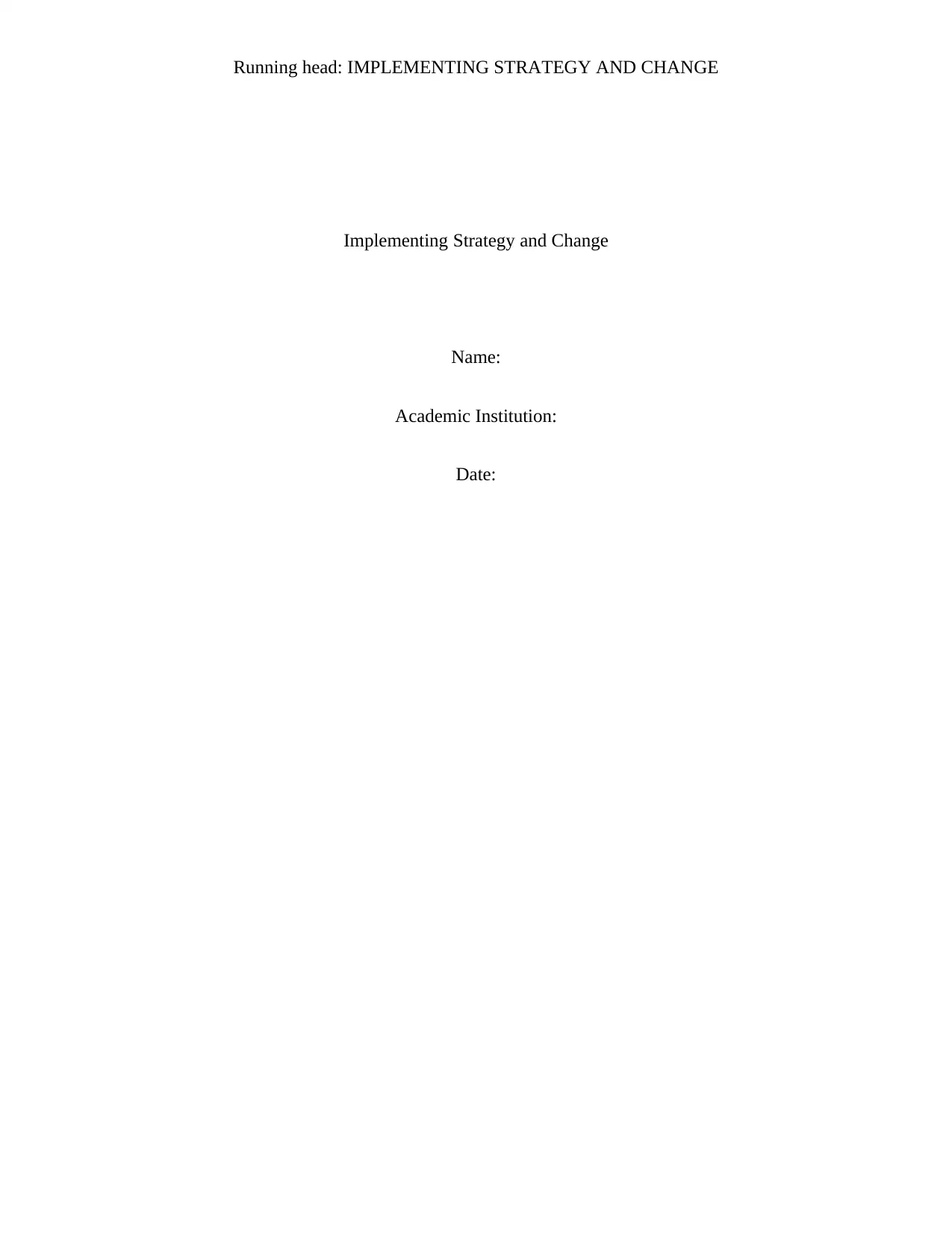
Running head: IMPLEMENTING STRATEGY AND CHANGE
Implementing Strategy and Change
Name:
Academic Institution:
Date:
Implementing Strategy and Change
Name:
Academic Institution:
Date:
Paraphrase This Document
Need a fresh take? Get an instant paraphrase of this document with our AI Paraphraser
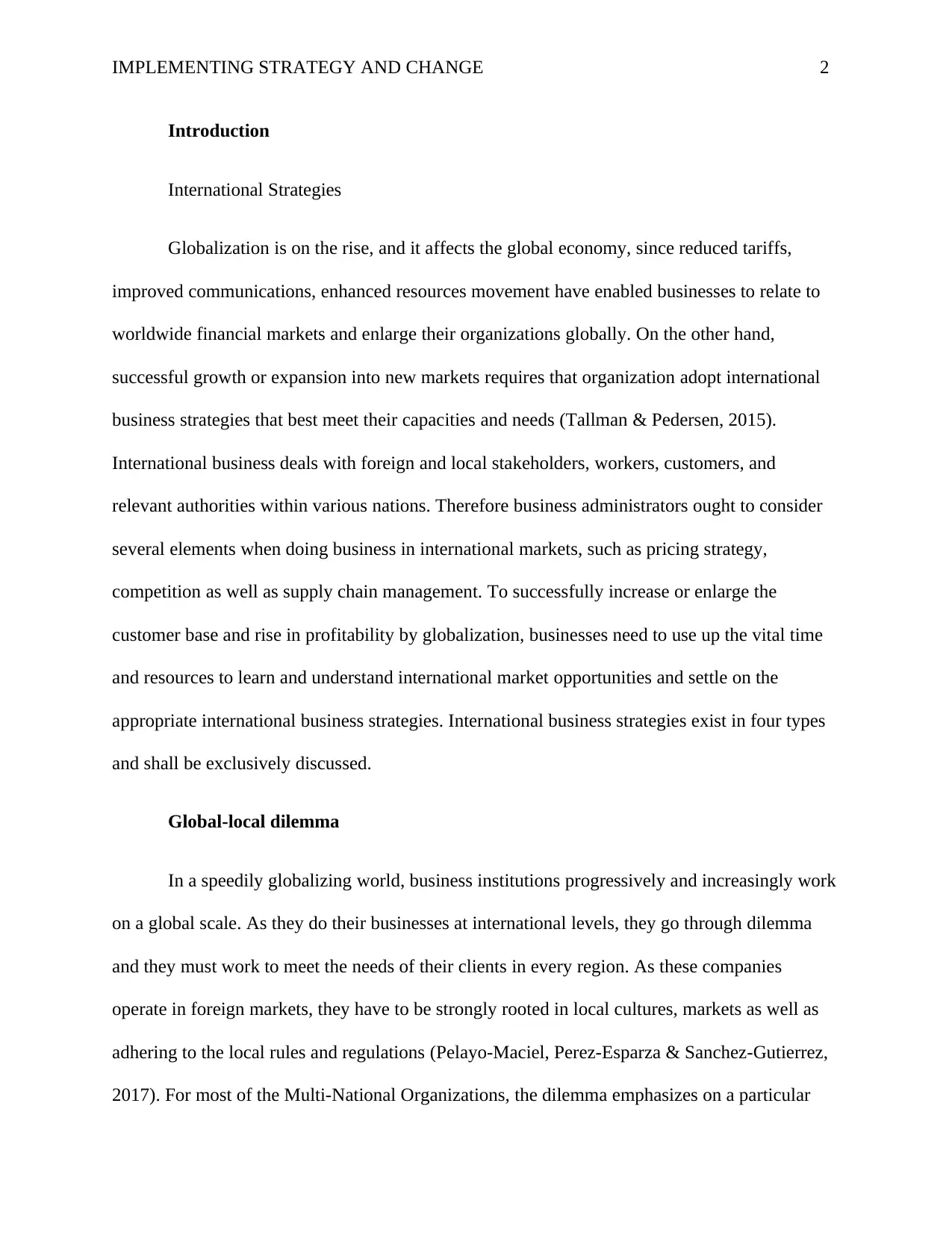
IMPLEMENTING STRATEGY AND CHANGE 2
Introduction
International Strategies
Globalization is on the rise, and it affects the global economy, since reduced tariffs,
improved communications, enhanced resources movement have enabled businesses to relate to
worldwide financial markets and enlarge their organizations globally. On the other hand,
successful growth or expansion into new markets requires that organization adopt international
business strategies that best meet their capacities and needs (Tallman & Pedersen, 2015).
International business deals with foreign and local stakeholders, workers, customers, and
relevant authorities within various nations. Therefore business administrators ought to consider
several elements when doing business in international markets, such as pricing strategy,
competition as well as supply chain management. To successfully increase or enlarge the
customer base and rise in profitability by globalization, businesses need to use up the vital time
and resources to learn and understand international market opportunities and settle on the
appropriate international business strategies. International business strategies exist in four types
and shall be exclusively discussed.
Global-local dilemma
In a speedily globalizing world, business institutions progressively and increasingly work
on a global scale. As they do their businesses at international levels, they go through dilemma
and they must work to meet the needs of their clients in every region. As these companies
operate in foreign markets, they have to be strongly rooted in local cultures, markets as well as
adhering to the local rules and regulations (Pelayo-Maciel, Perez-Esparza & Sanchez-Gutierrez,
2017). For most of the Multi-National Organizations, the dilemma emphasizes on a particular
Introduction
International Strategies
Globalization is on the rise, and it affects the global economy, since reduced tariffs,
improved communications, enhanced resources movement have enabled businesses to relate to
worldwide financial markets and enlarge their organizations globally. On the other hand,
successful growth or expansion into new markets requires that organization adopt international
business strategies that best meet their capacities and needs (Tallman & Pedersen, 2015).
International business deals with foreign and local stakeholders, workers, customers, and
relevant authorities within various nations. Therefore business administrators ought to consider
several elements when doing business in international markets, such as pricing strategy,
competition as well as supply chain management. To successfully increase or enlarge the
customer base and rise in profitability by globalization, businesses need to use up the vital time
and resources to learn and understand international market opportunities and settle on the
appropriate international business strategies. International business strategies exist in four types
and shall be exclusively discussed.
Global-local dilemma
In a speedily globalizing world, business institutions progressively and increasingly work
on a global scale. As they do their businesses at international levels, they go through dilemma
and they must work to meet the needs of their clients in every region. As these companies
operate in foreign markets, they have to be strongly rooted in local cultures, markets as well as
adhering to the local rules and regulations (Pelayo-Maciel, Perez-Esparza & Sanchez-Gutierrez,
2017). For most of the Multi-National Organizations, the dilemma emphasizes on a particular
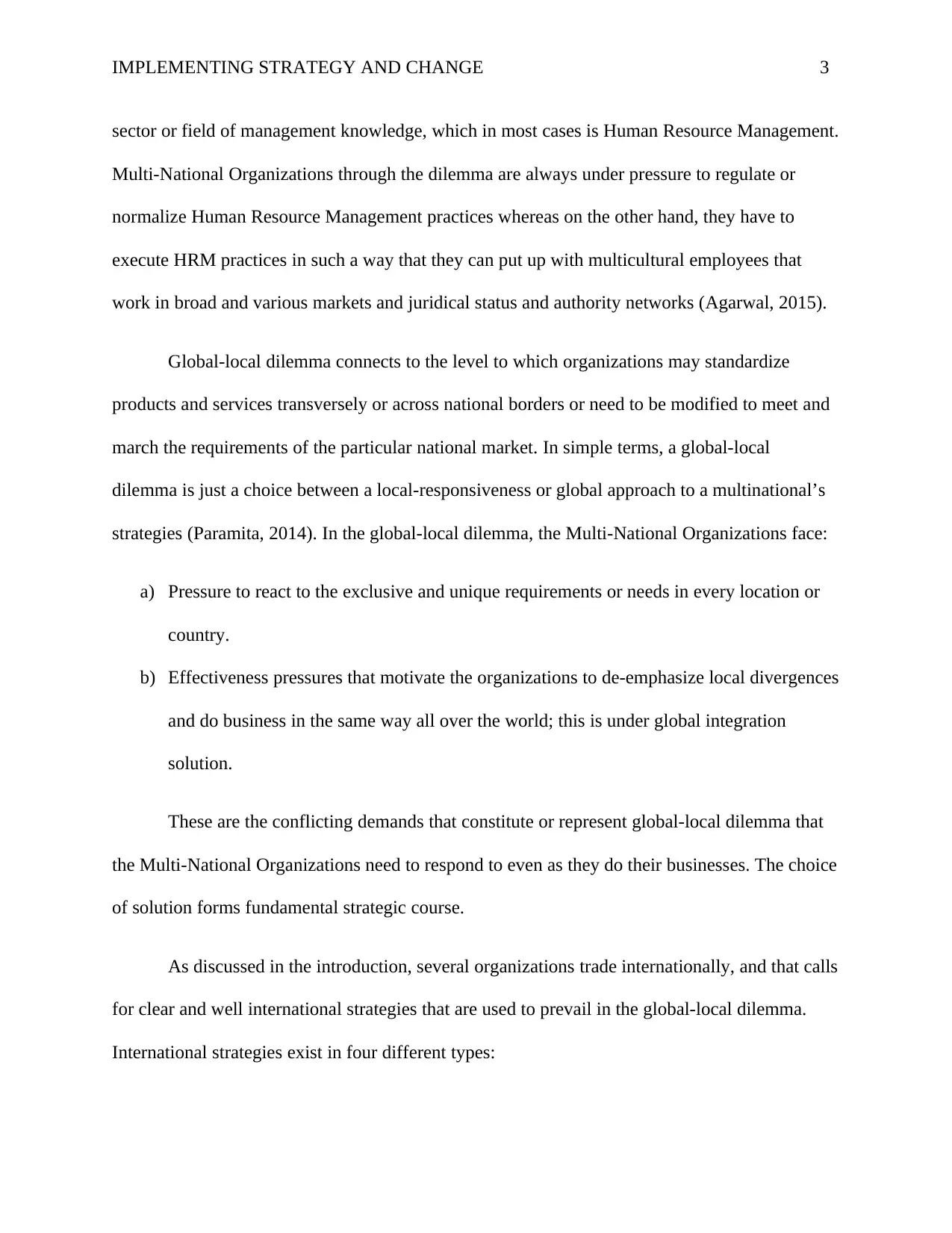
IMPLEMENTING STRATEGY AND CHANGE 3
sector or field of management knowledge, which in most cases is Human Resource Management.
Multi-National Organizations through the dilemma are always under pressure to regulate or
normalize Human Resource Management practices whereas on the other hand, they have to
execute HRM practices in such a way that they can put up with multicultural employees that
work in broad and various markets and juridical status and authority networks (Agarwal, 2015).
Global-local dilemma connects to the level to which organizations may standardize
products and services transversely or across national borders or need to be modified to meet and
march the requirements of the particular national market. In simple terms, a global-local
dilemma is just a choice between a local-responsiveness or global approach to a multinational’s
strategies (Paramita, 2014). In the global-local dilemma, the Multi-National Organizations face:
a) Pressure to react to the exclusive and unique requirements or needs in every location or
country.
b) Effectiveness pressures that motivate the organizations to de-emphasize local divergences
and do business in the same way all over the world; this is under global integration
solution.
These are the conflicting demands that constitute or represent global-local dilemma that
the Multi-National Organizations need to respond to even as they do their businesses. The choice
of solution forms fundamental strategic course.
As discussed in the introduction, several organizations trade internationally, and that calls
for clear and well international strategies that are used to prevail in the global-local dilemma.
International strategies exist in four different types:
sector or field of management knowledge, which in most cases is Human Resource Management.
Multi-National Organizations through the dilemma are always under pressure to regulate or
normalize Human Resource Management practices whereas on the other hand, they have to
execute HRM practices in such a way that they can put up with multicultural employees that
work in broad and various markets and juridical status and authority networks (Agarwal, 2015).
Global-local dilemma connects to the level to which organizations may standardize
products and services transversely or across national borders or need to be modified to meet and
march the requirements of the particular national market. In simple terms, a global-local
dilemma is just a choice between a local-responsiveness or global approach to a multinational’s
strategies (Paramita, 2014). In the global-local dilemma, the Multi-National Organizations face:
a) Pressure to react to the exclusive and unique requirements or needs in every location or
country.
b) Effectiveness pressures that motivate the organizations to de-emphasize local divergences
and do business in the same way all over the world; this is under global integration
solution.
These are the conflicting demands that constitute or represent global-local dilemma that
the Multi-National Organizations need to respond to even as they do their businesses. The choice
of solution forms fundamental strategic course.
As discussed in the introduction, several organizations trade internationally, and that calls
for clear and well international strategies that are used to prevail in the global-local dilemma.
International strategies exist in four different types:
⊘ This is a preview!⊘
Do you want full access?
Subscribe today to unlock all pages.

Trusted by 1+ million students worldwide
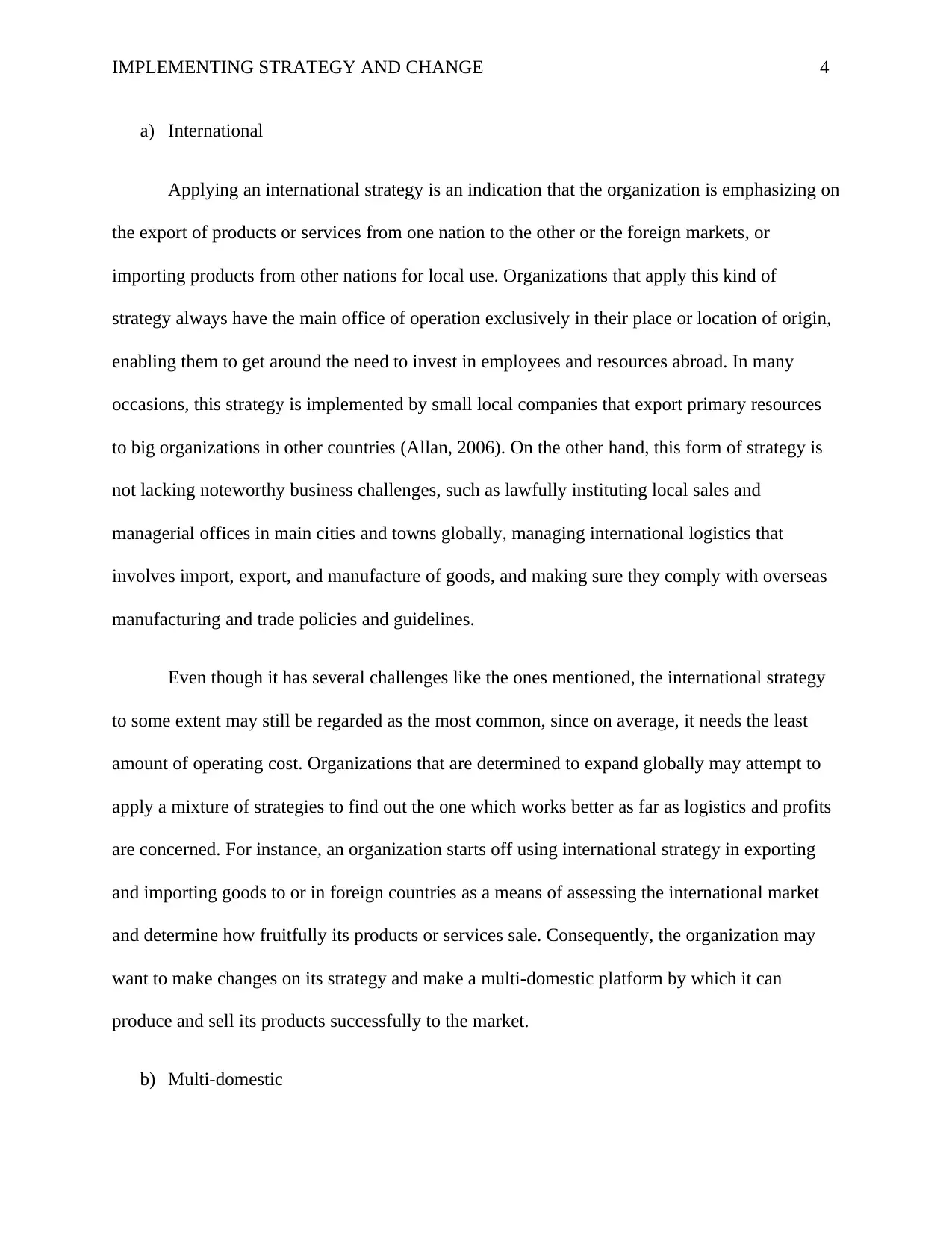
IMPLEMENTING STRATEGY AND CHANGE 4
a) International
Applying an international strategy is an indication that the organization is emphasizing on
the export of products or services from one nation to the other or the foreign markets, or
importing products from other nations for local use. Organizations that apply this kind of
strategy always have the main office of operation exclusively in their place or location of origin,
enabling them to get around the need to invest in employees and resources abroad. In many
occasions, this strategy is implemented by small local companies that export primary resources
to big organizations in other countries (Allan, 2006). On the other hand, this form of strategy is
not lacking noteworthy business challenges, such as lawfully instituting local sales and
managerial offices in main cities and towns globally, managing international logistics that
involves import, export, and manufacture of goods, and making sure they comply with overseas
manufacturing and trade policies and guidelines.
Even though it has several challenges like the ones mentioned, the international strategy
to some extent may still be regarded as the most common, since on average, it needs the least
amount of operating cost. Organizations that are determined to expand globally may attempt to
apply a mixture of strategies to find out the one which works better as far as logistics and profits
are concerned. For instance, an organization starts off using international strategy in exporting
and importing goods to or in foreign countries as a means of assessing the international market
and determine how fruitfully its products or services sale. Consequently, the organization may
want to make changes on its strategy and make a multi-domestic platform by which it can
produce and sell its products successfully to the market.
b) Multi-domestic
a) International
Applying an international strategy is an indication that the organization is emphasizing on
the export of products or services from one nation to the other or the foreign markets, or
importing products from other nations for local use. Organizations that apply this kind of
strategy always have the main office of operation exclusively in their place or location of origin,
enabling them to get around the need to invest in employees and resources abroad. In many
occasions, this strategy is implemented by small local companies that export primary resources
to big organizations in other countries (Allan, 2006). On the other hand, this form of strategy is
not lacking noteworthy business challenges, such as lawfully instituting local sales and
managerial offices in main cities and towns globally, managing international logistics that
involves import, export, and manufacture of goods, and making sure they comply with overseas
manufacturing and trade policies and guidelines.
Even though it has several challenges like the ones mentioned, the international strategy
to some extent may still be regarded as the most common, since on average, it needs the least
amount of operating cost. Organizations that are determined to expand globally may attempt to
apply a mixture of strategies to find out the one which works better as far as logistics and profits
are concerned. For instance, an organization starts off using international strategy in exporting
and importing goods to or in foreign countries as a means of assessing the international market
and determine how fruitfully its products or services sale. Consequently, the organization may
want to make changes on its strategy and make a multi-domestic platform by which it can
produce and sell its products successfully to the market.
b) Multi-domestic
Paraphrase This Document
Need a fresh take? Get an instant paraphrase of this document with our AI Paraphraser
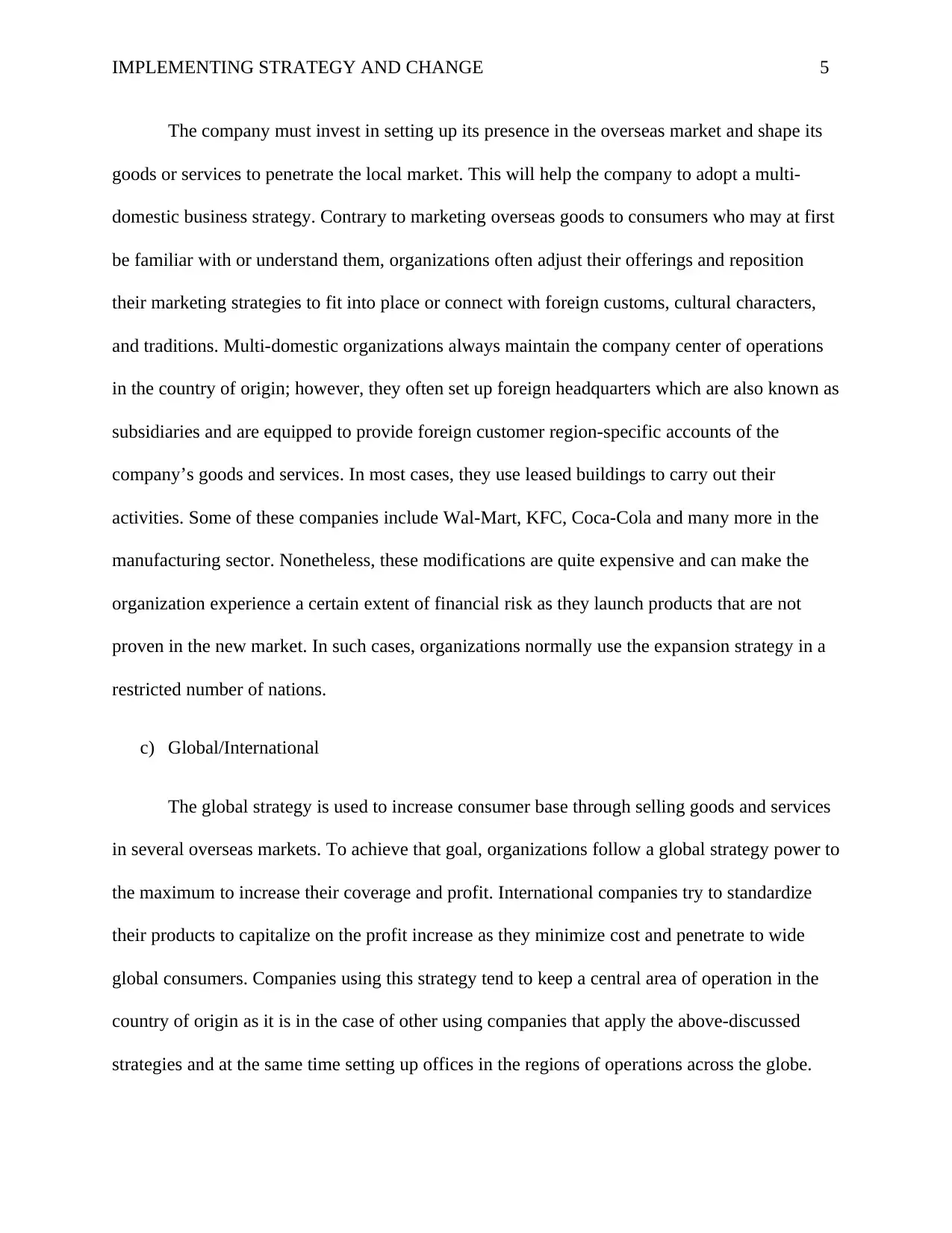
IMPLEMENTING STRATEGY AND CHANGE 5
The company must invest in setting up its presence in the overseas market and shape its
goods or services to penetrate the local market. This will help the company to adopt a multi-
domestic business strategy. Contrary to marketing overseas goods to consumers who may at first
be familiar with or understand them, organizations often adjust their offerings and reposition
their marketing strategies to fit into place or connect with foreign customs, cultural characters,
and traditions. Multi-domestic organizations always maintain the company center of operations
in the country of origin; however, they often set up foreign headquarters which are also known as
subsidiaries and are equipped to provide foreign customer region-specific accounts of the
company’s goods and services. In most cases, they use leased buildings to carry out their
activities. Some of these companies include Wal-Mart, KFC, Coca-Cola and many more in the
manufacturing sector. Nonetheless, these modifications are quite expensive and can make the
organization experience a certain extent of financial risk as they launch products that are not
proven in the new market. In such cases, organizations normally use the expansion strategy in a
restricted number of nations.
c) Global/International
The global strategy is used to increase consumer base through selling goods and services
in several overseas markets. To achieve that goal, organizations follow a global strategy power to
the maximum to increase their coverage and profit. International companies try to standardize
their products to capitalize on the profit increase as they minimize cost and penetrate to wide
global consumers. Companies using this strategy tend to keep a central area of operation in the
country of origin as it is in the case of other using companies that apply the above-discussed
strategies and at the same time setting up offices in the regions of operations across the globe.
The company must invest in setting up its presence in the overseas market and shape its
goods or services to penetrate the local market. This will help the company to adopt a multi-
domestic business strategy. Contrary to marketing overseas goods to consumers who may at first
be familiar with or understand them, organizations often adjust their offerings and reposition
their marketing strategies to fit into place or connect with foreign customs, cultural characters,
and traditions. Multi-domestic organizations always maintain the company center of operations
in the country of origin; however, they often set up foreign headquarters which are also known as
subsidiaries and are equipped to provide foreign customer region-specific accounts of the
company’s goods and services. In most cases, they use leased buildings to carry out their
activities. Some of these companies include Wal-Mart, KFC, Coca-Cola and many more in the
manufacturing sector. Nonetheless, these modifications are quite expensive and can make the
organization experience a certain extent of financial risk as they launch products that are not
proven in the new market. In such cases, organizations normally use the expansion strategy in a
restricted number of nations.
c) Global/International
The global strategy is used to increase consumer base through selling goods and services
in several overseas markets. To achieve that goal, organizations follow a global strategy power to
the maximum to increase their coverage and profit. International companies try to standardize
their products to capitalize on the profit increase as they minimize cost and penetrate to wide
global consumers. Companies using this strategy tend to keep a central area of operation in the
country of origin as it is in the case of other using companies that apply the above-discussed
strategies and at the same time setting up offices in the regions of operations across the globe.
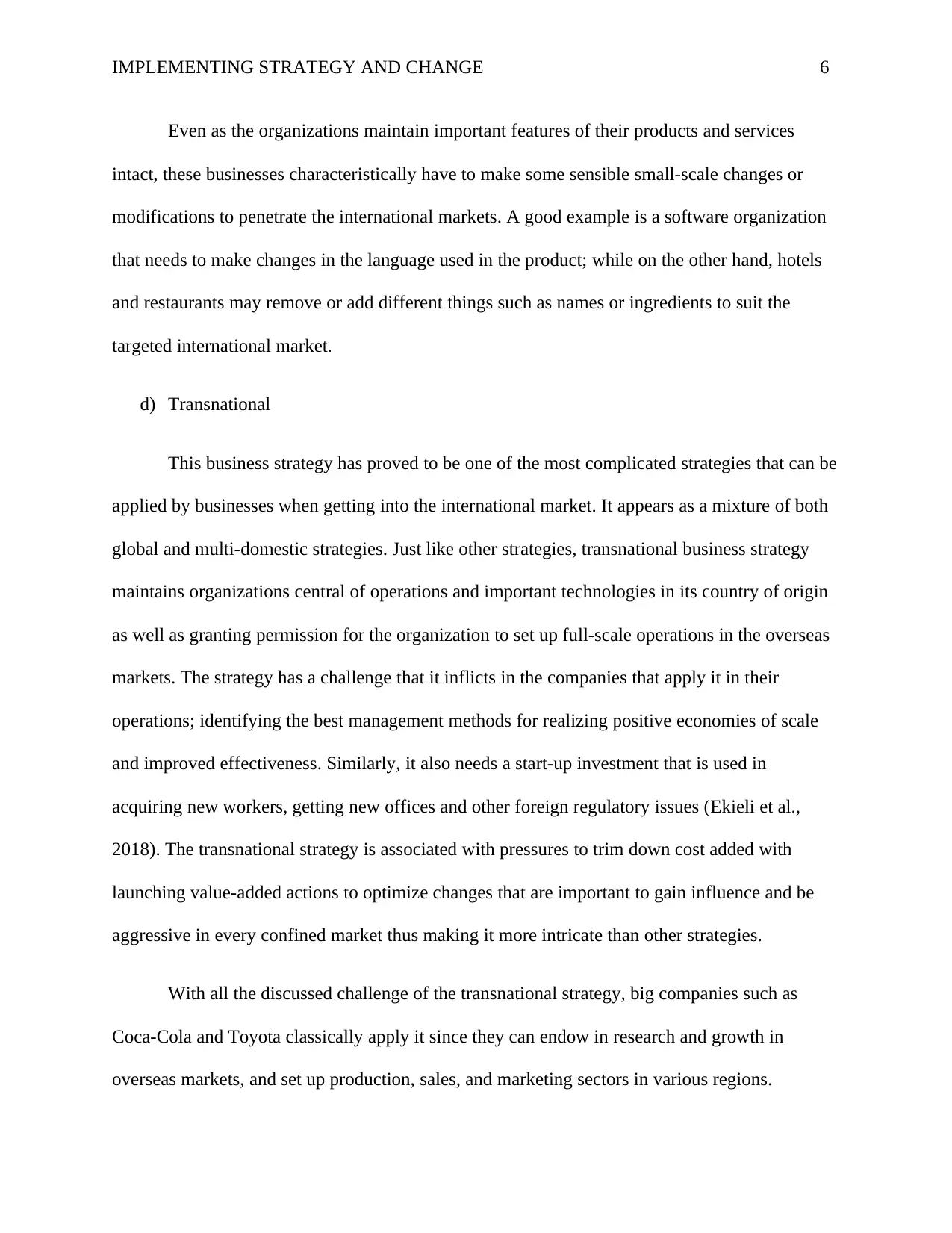
IMPLEMENTING STRATEGY AND CHANGE 6
Even as the organizations maintain important features of their products and services
intact, these businesses characteristically have to make some sensible small-scale changes or
modifications to penetrate the international markets. A good example is a software organization
that needs to make changes in the language used in the product; while on the other hand, hotels
and restaurants may remove or add different things such as names or ingredients to suit the
targeted international market.
d) Transnational
This business strategy has proved to be one of the most complicated strategies that can be
applied by businesses when getting into the international market. It appears as a mixture of both
global and multi-domestic strategies. Just like other strategies, transnational business strategy
maintains organizations central of operations and important technologies in its country of origin
as well as granting permission for the organization to set up full-scale operations in the overseas
markets. The strategy has a challenge that it inflicts in the companies that apply it in their
operations; identifying the best management methods for realizing positive economies of scale
and improved effectiveness. Similarly, it also needs a start-up investment that is used in
acquiring new workers, getting new offices and other foreign regulatory issues (Ekieli et al.,
2018). The transnational strategy is associated with pressures to trim down cost added with
launching value-added actions to optimize changes that are important to gain influence and be
aggressive in every confined market thus making it more intricate than other strategies.
With all the discussed challenge of the transnational strategy, big companies such as
Coca-Cola and Toyota classically apply it since they can endow in research and growth in
overseas markets, and set up production, sales, and marketing sectors in various regions.
Even as the organizations maintain important features of their products and services
intact, these businesses characteristically have to make some sensible small-scale changes or
modifications to penetrate the international markets. A good example is a software organization
that needs to make changes in the language used in the product; while on the other hand, hotels
and restaurants may remove or add different things such as names or ingredients to suit the
targeted international market.
d) Transnational
This business strategy has proved to be one of the most complicated strategies that can be
applied by businesses when getting into the international market. It appears as a mixture of both
global and multi-domestic strategies. Just like other strategies, transnational business strategy
maintains organizations central of operations and important technologies in its country of origin
as well as granting permission for the organization to set up full-scale operations in the overseas
markets. The strategy has a challenge that it inflicts in the companies that apply it in their
operations; identifying the best management methods for realizing positive economies of scale
and improved effectiveness. Similarly, it also needs a start-up investment that is used in
acquiring new workers, getting new offices and other foreign regulatory issues (Ekieli et al.,
2018). The transnational strategy is associated with pressures to trim down cost added with
launching value-added actions to optimize changes that are important to gain influence and be
aggressive in every confined market thus making it more intricate than other strategies.
With all the discussed challenge of the transnational strategy, big companies such as
Coca-Cola and Toyota classically apply it since they can endow in research and growth in
overseas markets, and set up production, sales, and marketing sectors in various regions.
⊘ This is a preview!⊘
Do you want full access?
Subscribe today to unlock all pages.

Trusted by 1+ million students worldwide
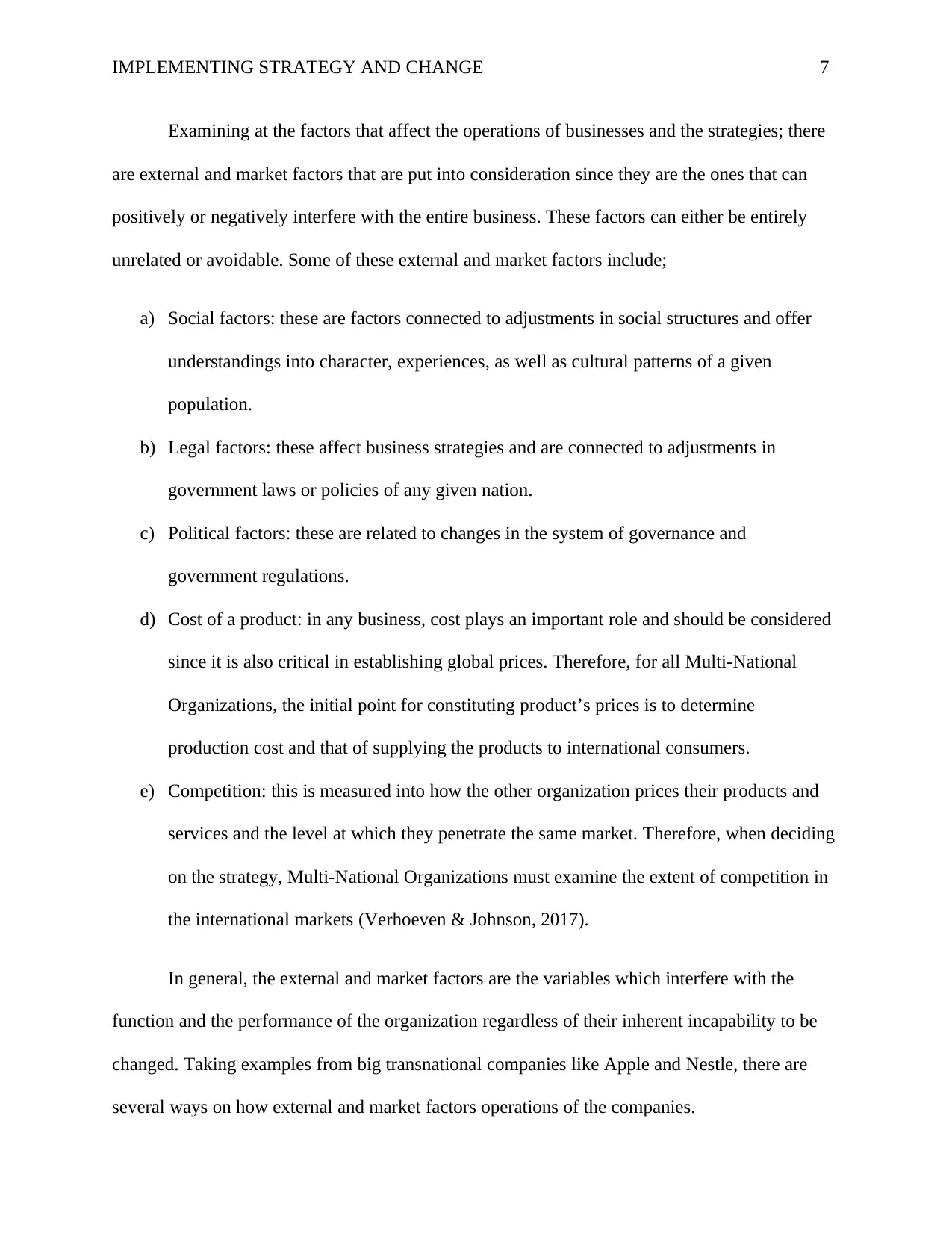
IMPLEMENTING STRATEGY AND CHANGE 7
Examining at the factors that affect the operations of businesses and the strategies; there
are external and market factors that are put into consideration since they are the ones that can
positively or negatively interfere with the entire business. These factors can either be entirely
unrelated or avoidable. Some of these external and market factors include;
a) Social factors: these are factors connected to adjustments in social structures and offer
understandings into character, experiences, as well as cultural patterns of a given
population.
b) Legal factors: these affect business strategies and are connected to adjustments in
government laws or policies of any given nation.
c) Political factors: these are related to changes in the system of governance and
government regulations.
d) Cost of a product: in any business, cost plays an important role and should be considered
since it is also critical in establishing global prices. Therefore, for all Multi-National
Organizations, the initial point for constituting product’s prices is to determine
production cost and that of supplying the products to international consumers.
e) Competition: this is measured into how the other organization prices their products and
services and the level at which they penetrate the same market. Therefore, when deciding
on the strategy, Multi-National Organizations must examine the extent of competition in
the international markets (Verhoeven & Johnson, 2017).
In general, the external and market factors are the variables which interfere with the
function and the performance of the organization regardless of their inherent incapability to be
changed. Taking examples from big transnational companies like Apple and Nestle, there are
several ways on how external and market factors operations of the companies.
Examining at the factors that affect the operations of businesses and the strategies; there
are external and market factors that are put into consideration since they are the ones that can
positively or negatively interfere with the entire business. These factors can either be entirely
unrelated or avoidable. Some of these external and market factors include;
a) Social factors: these are factors connected to adjustments in social structures and offer
understandings into character, experiences, as well as cultural patterns of a given
population.
b) Legal factors: these affect business strategies and are connected to adjustments in
government laws or policies of any given nation.
c) Political factors: these are related to changes in the system of governance and
government regulations.
d) Cost of a product: in any business, cost plays an important role and should be considered
since it is also critical in establishing global prices. Therefore, for all Multi-National
Organizations, the initial point for constituting product’s prices is to determine
production cost and that of supplying the products to international consumers.
e) Competition: this is measured into how the other organization prices their products and
services and the level at which they penetrate the same market. Therefore, when deciding
on the strategy, Multi-National Organizations must examine the extent of competition in
the international markets (Verhoeven & Johnson, 2017).
In general, the external and market factors are the variables which interfere with the
function and the performance of the organization regardless of their inherent incapability to be
changed. Taking examples from big transnational companies like Apple and Nestle, there are
several ways on how external and market factors operations of the companies.
Paraphrase This Document
Need a fresh take? Get an instant paraphrase of this document with our AI Paraphraser
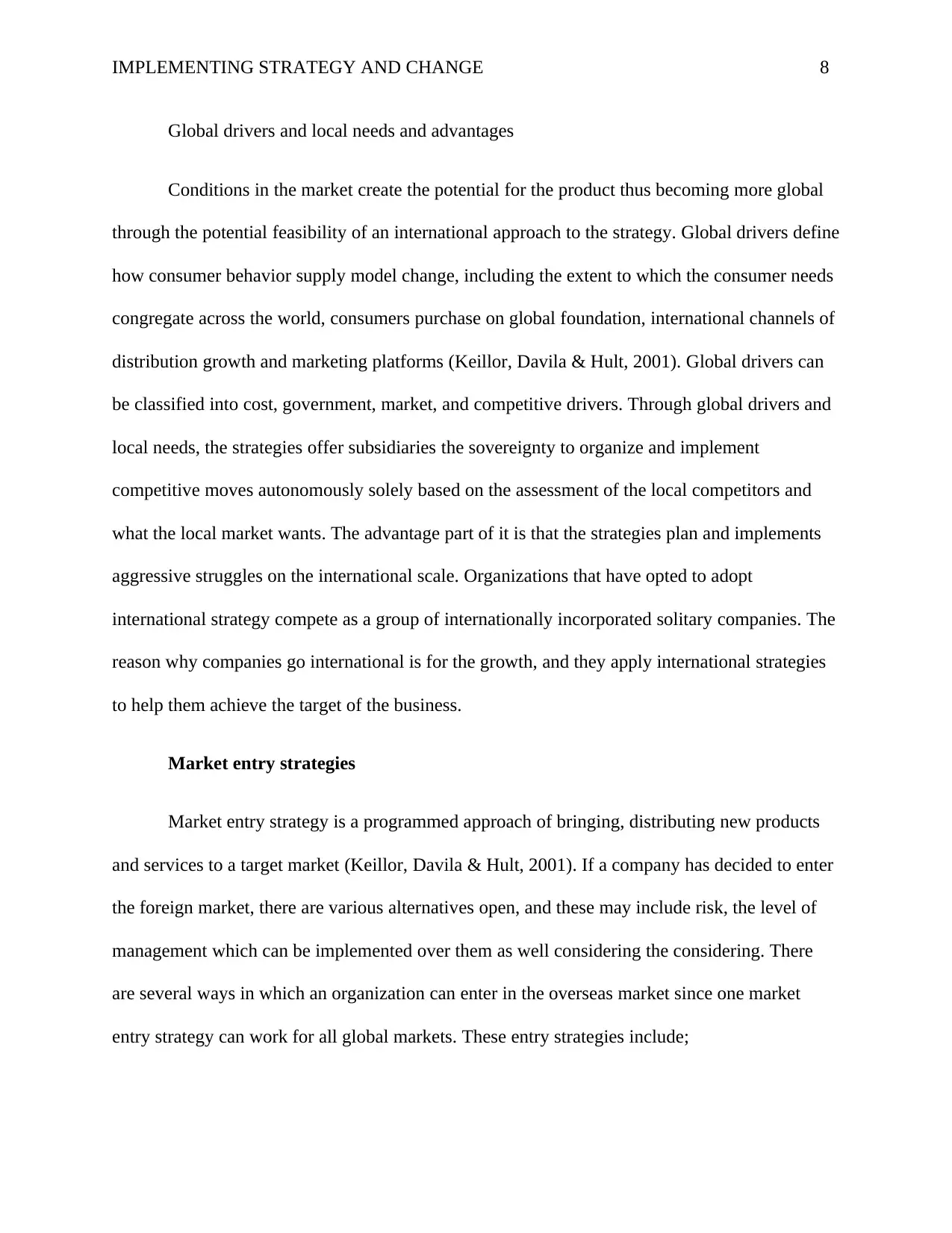
IMPLEMENTING STRATEGY AND CHANGE 8
Global drivers and local needs and advantages
Conditions in the market create the potential for the product thus becoming more global
through the potential feasibility of an international approach to the strategy. Global drivers define
how consumer behavior supply model change, including the extent to which the consumer needs
congregate across the world, consumers purchase on global foundation, international channels of
distribution growth and marketing platforms (Keillor, Davila & Hult, 2001). Global drivers can
be classified into cost, government, market, and competitive drivers. Through global drivers and
local needs, the strategies offer subsidiaries the sovereignty to organize and implement
competitive moves autonomously solely based on the assessment of the local competitors and
what the local market wants. The advantage part of it is that the strategies plan and implements
aggressive struggles on the international scale. Organizations that have opted to adopt
international strategy compete as a group of internationally incorporated solitary companies. The
reason why companies go international is for the growth, and they apply international strategies
to help them achieve the target of the business.
Market entry strategies
Market entry strategy is a programmed approach of bringing, distributing new products
and services to a target market (Keillor, Davila & Hult, 2001). If a company has decided to enter
the foreign market, there are various alternatives open, and these may include risk, the level of
management which can be implemented over them as well considering the considering. There
are several ways in which an organization can enter in the overseas market since one market
entry strategy can work for all global markets. These entry strategies include;
Global drivers and local needs and advantages
Conditions in the market create the potential for the product thus becoming more global
through the potential feasibility of an international approach to the strategy. Global drivers define
how consumer behavior supply model change, including the extent to which the consumer needs
congregate across the world, consumers purchase on global foundation, international channels of
distribution growth and marketing platforms (Keillor, Davila & Hult, 2001). Global drivers can
be classified into cost, government, market, and competitive drivers. Through global drivers and
local needs, the strategies offer subsidiaries the sovereignty to organize and implement
competitive moves autonomously solely based on the assessment of the local competitors and
what the local market wants. The advantage part of it is that the strategies plan and implements
aggressive struggles on the international scale. Organizations that have opted to adopt
international strategy compete as a group of internationally incorporated solitary companies. The
reason why companies go international is for the growth, and they apply international strategies
to help them achieve the target of the business.
Market entry strategies
Market entry strategy is a programmed approach of bringing, distributing new products
and services to a target market (Keillor, Davila & Hult, 2001). If a company has decided to enter
the foreign market, there are various alternatives open, and these may include risk, the level of
management which can be implemented over them as well considering the considering. There
are several ways in which an organization can enter in the overseas market since one market
entry strategy can work for all global markets. These entry strategies include;
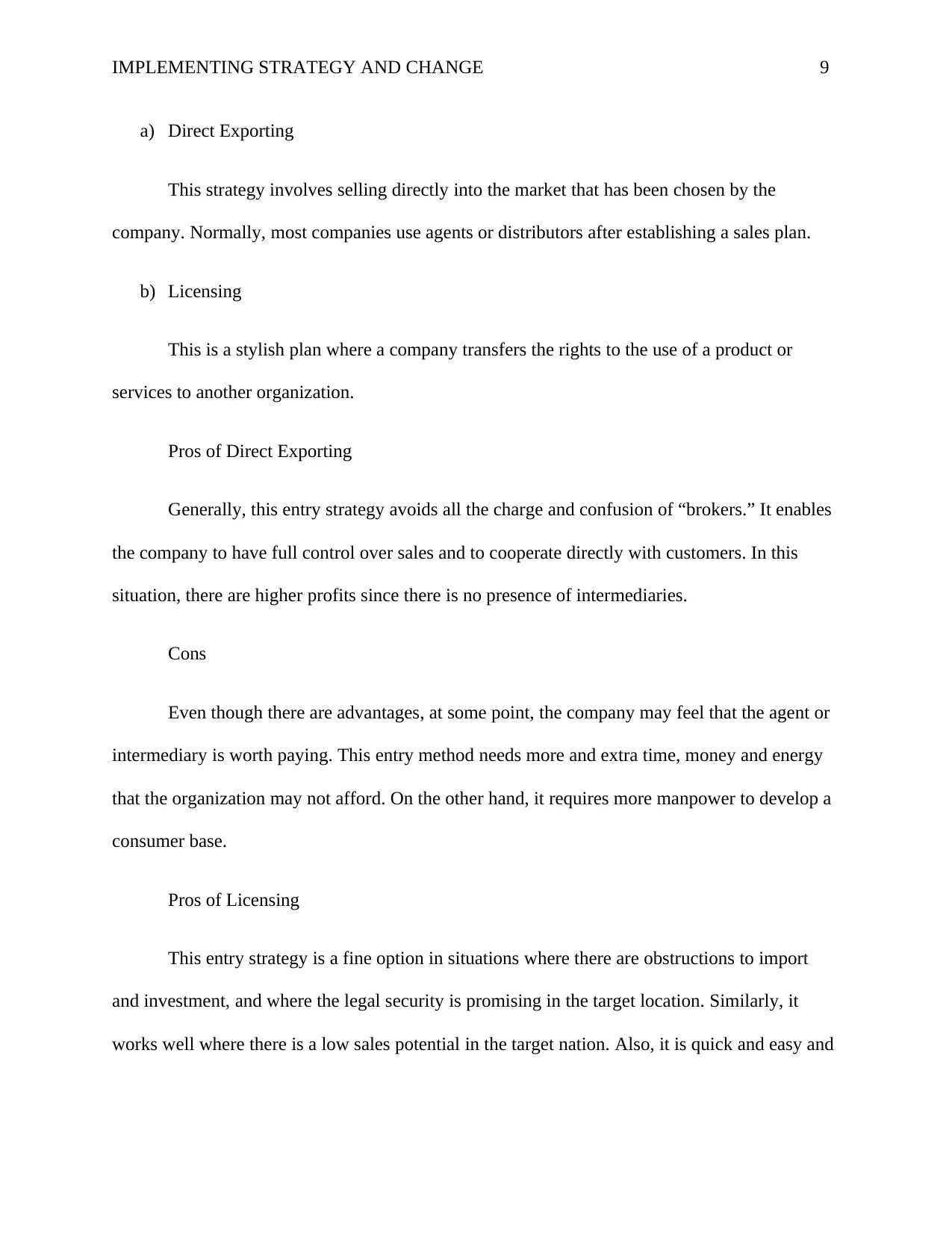
IMPLEMENTING STRATEGY AND CHANGE 9
a) Direct Exporting
This strategy involves selling directly into the market that has been chosen by the
company. Normally, most companies use agents or distributors after establishing a sales plan.
b) Licensing
This is a stylish plan where a company transfers the rights to the use of a product or
services to another organization.
Pros of Direct Exporting
Generally, this entry strategy avoids all the charge and confusion of “brokers.” It enables
the company to have full control over sales and to cooperate directly with customers. In this
situation, there are higher profits since there is no presence of intermediaries.
Cons
Even though there are advantages, at some point, the company may feel that the agent or
intermediary is worth paying. This entry method needs more and extra time, money and energy
that the organization may not afford. On the other hand, it requires more manpower to develop a
consumer base.
Pros of Licensing
This entry strategy is a fine option in situations where there are obstructions to import
and investment, and where the legal security is promising in the target location. Similarly, it
works well where there is a low sales potential in the target nation. Also, it is quick and easy and
a) Direct Exporting
This strategy involves selling directly into the market that has been chosen by the
company. Normally, most companies use agents or distributors after establishing a sales plan.
b) Licensing
This is a stylish plan where a company transfers the rights to the use of a product or
services to another organization.
Pros of Direct Exporting
Generally, this entry strategy avoids all the charge and confusion of “brokers.” It enables
the company to have full control over sales and to cooperate directly with customers. In this
situation, there are higher profits since there is no presence of intermediaries.
Cons
Even though there are advantages, at some point, the company may feel that the agent or
intermediary is worth paying. This entry method needs more and extra time, money and energy
that the organization may not afford. On the other hand, it requires more manpower to develop a
consumer base.
Pros of Licensing
This entry strategy is a fine option in situations where there are obstructions to import
and investment, and where the legal security is promising in the target location. Similarly, it
works well where there is a low sales potential in the target nation. Also, it is quick and easy and
⊘ This is a preview!⊘
Do you want full access?
Subscribe today to unlock all pages.

Trusted by 1+ million students worldwide
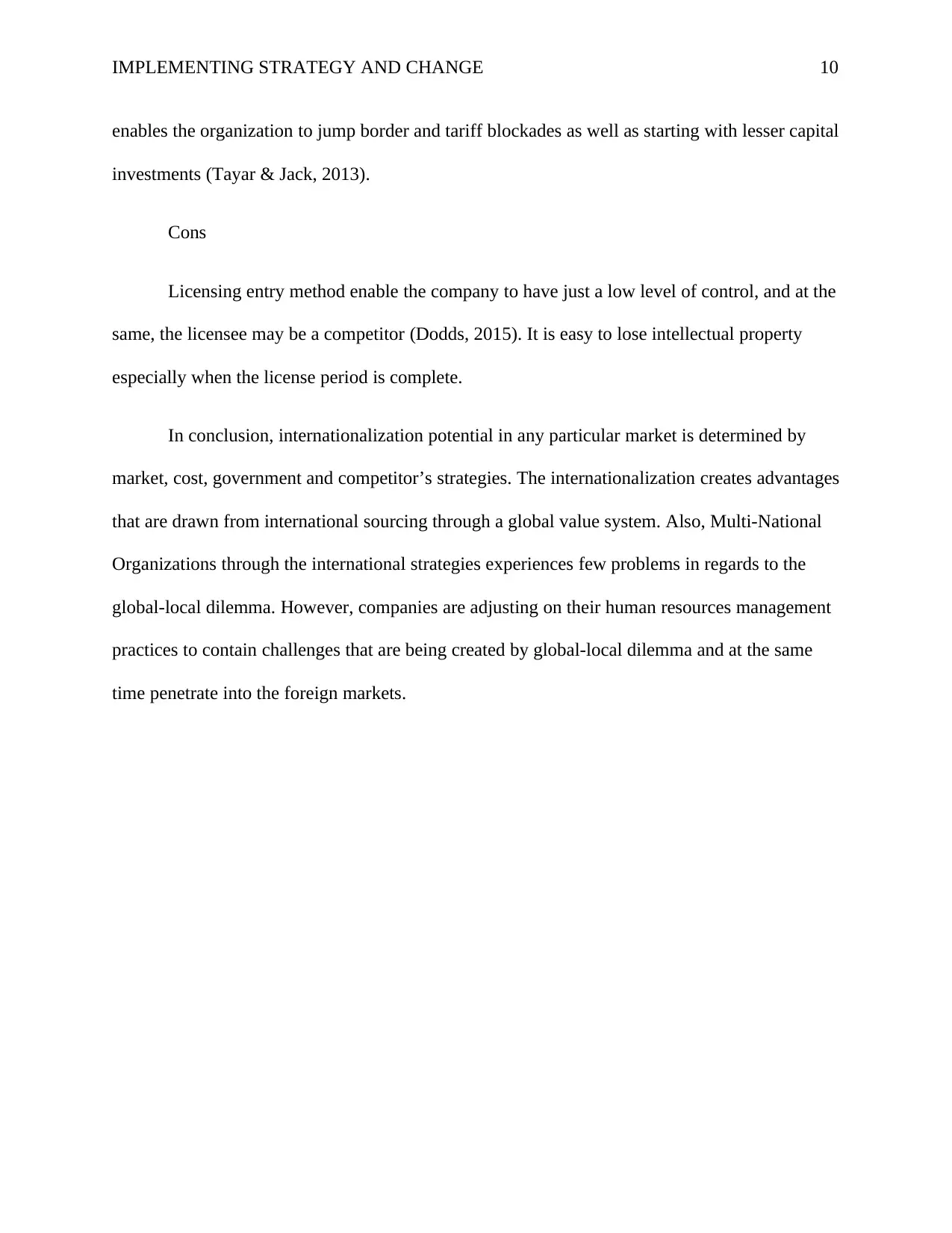
IMPLEMENTING STRATEGY AND CHANGE 10
enables the organization to jump border and tariff blockades as well as starting with lesser capital
investments (Tayar & Jack, 2013).
Cons
Licensing entry method enable the company to have just a low level of control, and at the
same, the licensee may be a competitor (Dodds, 2015). It is easy to lose intellectual property
especially when the license period is complete.
In conclusion, internationalization potential in any particular market is determined by
market, cost, government and competitor’s strategies. The internationalization creates advantages
that are drawn from international sourcing through a global value system. Also, Multi-National
Organizations through the international strategies experiences few problems in regards to the
global-local dilemma. However, companies are adjusting on their human resources management
practices to contain challenges that are being created by global-local dilemma and at the same
time penetrate into the foreign markets.
enables the organization to jump border and tariff blockades as well as starting with lesser capital
investments (Tayar & Jack, 2013).
Cons
Licensing entry method enable the company to have just a low level of control, and at the
same, the licensee may be a competitor (Dodds, 2015). It is easy to lose intellectual property
especially when the license period is complete.
In conclusion, internationalization potential in any particular market is determined by
market, cost, government and competitor’s strategies. The internationalization creates advantages
that are drawn from international sourcing through a global value system. Also, Multi-National
Organizations through the international strategies experiences few problems in regards to the
global-local dilemma. However, companies are adjusting on their human resources management
practices to contain challenges that are being created by global-local dilemma and at the same
time penetrate into the foreign markets.
Paraphrase This Document
Need a fresh take? Get an instant paraphrase of this document with our AI Paraphraser
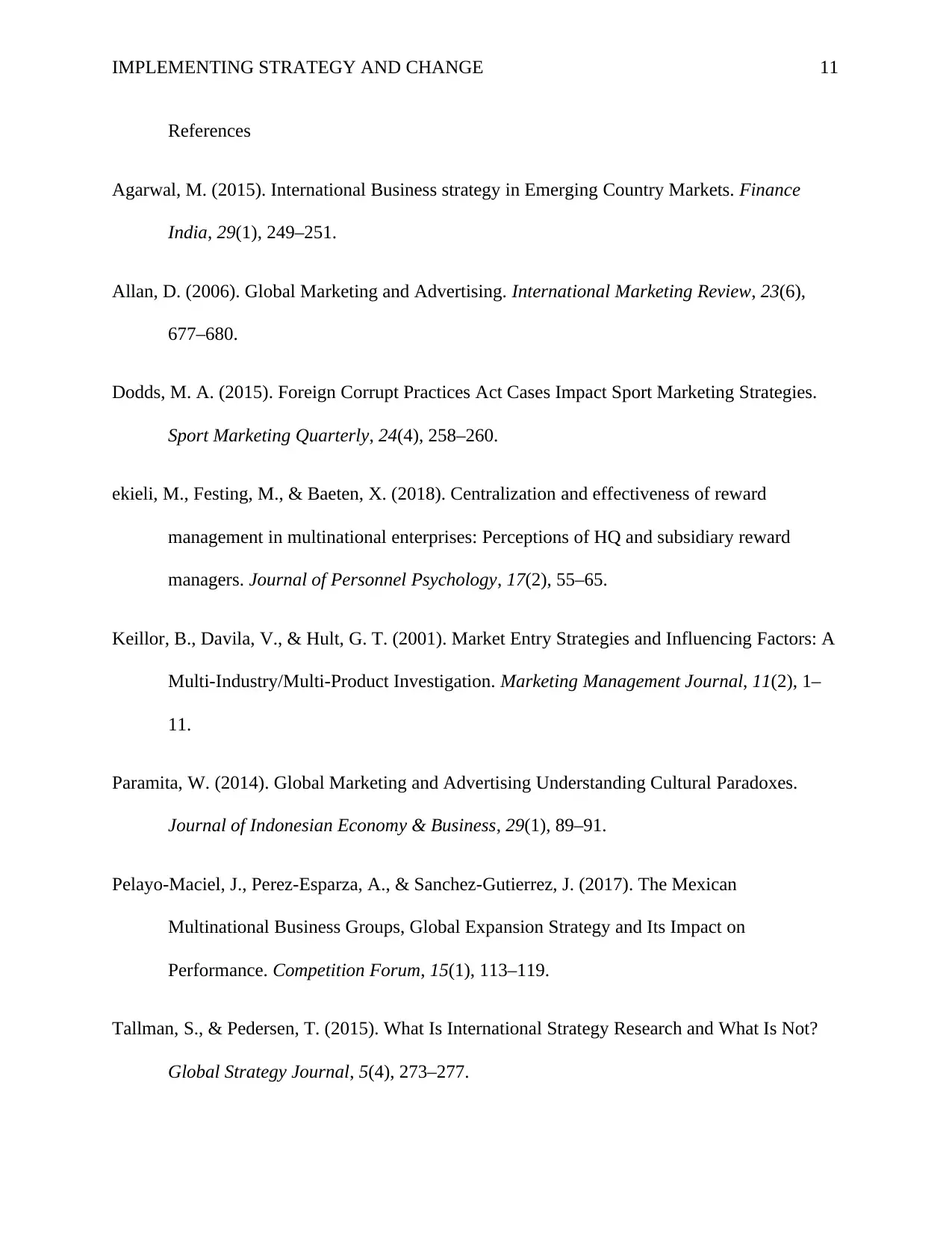
IMPLEMENTING STRATEGY AND CHANGE 11
References
Agarwal, M. (2015). International Business strategy in Emerging Country Markets. Finance
India, 29(1), 249–251.
Allan, D. (2006). Global Marketing and Advertising. International Marketing Review, 23(6),
677–680.
Dodds, M. A. (2015). Foreign Corrupt Practices Act Cases Impact Sport Marketing Strategies.
Sport Marketing Quarterly, 24(4), 258–260.
ekieli, M., Festing, M., & Baeten, X. (2018). Centralization and effectiveness of reward
management in multinational enterprises: Perceptions of HQ and subsidiary reward
managers. Journal of Personnel Psychology, 17(2), 55–65.
Keillor, B., Davila, V., & Hult, G. T. (2001). Market Entry Strategies and Influencing Factors: A
Multi-Industry/Multi-Product Investigation. Marketing Management Journal, 11(2), 1–
11.
Paramita, W. (2014). Global Marketing and Advertising Understanding Cultural Paradoxes.
Journal of Indonesian Economy & Business, 29(1), 89–91.
Pelayo-Maciel, J., Perez-Esparza, A., & Sanchez-Gutierrez, J. (2017). The Mexican
Multinational Business Groups, Global Expansion Strategy and Its Impact on
Performance. Competition Forum, 15(1), 113–119.
Tallman, S., & Pedersen, T. (2015). What Is International Strategy Research and What Is Not?
Global Strategy Journal, 5(4), 273–277.
References
Agarwal, M. (2015). International Business strategy in Emerging Country Markets. Finance
India, 29(1), 249–251.
Allan, D. (2006). Global Marketing and Advertising. International Marketing Review, 23(6),
677–680.
Dodds, M. A. (2015). Foreign Corrupt Practices Act Cases Impact Sport Marketing Strategies.
Sport Marketing Quarterly, 24(4), 258–260.
ekieli, M., Festing, M., & Baeten, X. (2018). Centralization and effectiveness of reward
management in multinational enterprises: Perceptions of HQ and subsidiary reward
managers. Journal of Personnel Psychology, 17(2), 55–65.
Keillor, B., Davila, V., & Hult, G. T. (2001). Market Entry Strategies and Influencing Factors: A
Multi-Industry/Multi-Product Investigation. Marketing Management Journal, 11(2), 1–
11.
Paramita, W. (2014). Global Marketing and Advertising Understanding Cultural Paradoxes.
Journal of Indonesian Economy & Business, 29(1), 89–91.
Pelayo-Maciel, J., Perez-Esparza, A., & Sanchez-Gutierrez, J. (2017). The Mexican
Multinational Business Groups, Global Expansion Strategy and Its Impact on
Performance. Competition Forum, 15(1), 113–119.
Tallman, S., & Pedersen, T. (2015). What Is International Strategy Research and What Is Not?
Global Strategy Journal, 5(4), 273–277.
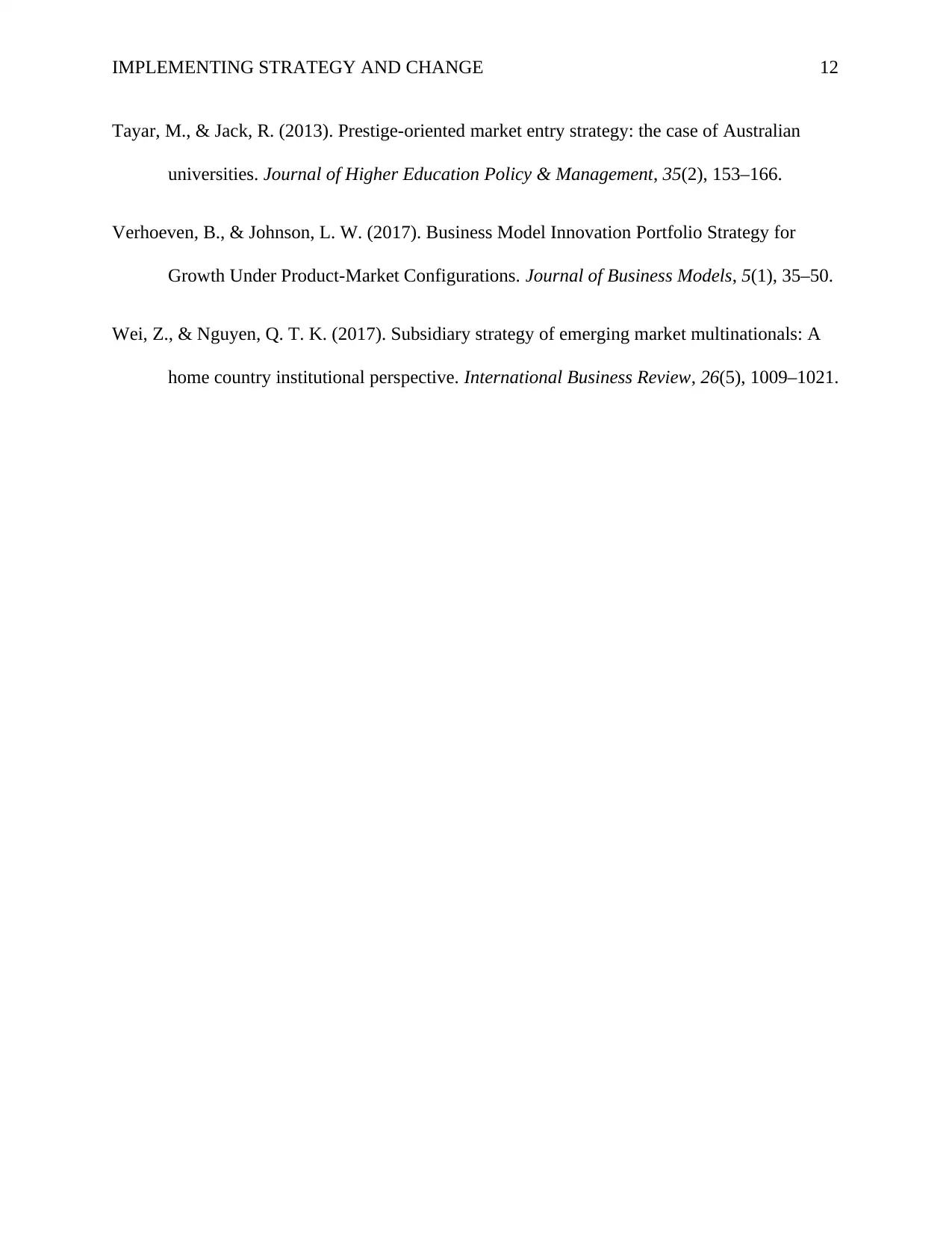
IMPLEMENTING STRATEGY AND CHANGE 12
Tayar, M., & Jack, R. (2013). Prestige-oriented market entry strategy: the case of Australian
universities. Journal of Higher Education Policy & Management, 35(2), 153–166.
Verhoeven, B., & Johnson, L. W. (2017). Business Model Innovation Portfolio Strategy for
Growth Under Product-Market Configurations. Journal of Business Models, 5(1), 35–50.
Wei, Z., & Nguyen, Q. T. K. (2017). Subsidiary strategy of emerging market multinationals: A
home country institutional perspective. International Business Review, 26(5), 1009–1021.
Tayar, M., & Jack, R. (2013). Prestige-oriented market entry strategy: the case of Australian
universities. Journal of Higher Education Policy & Management, 35(2), 153–166.
Verhoeven, B., & Johnson, L. W. (2017). Business Model Innovation Portfolio Strategy for
Growth Under Product-Market Configurations. Journal of Business Models, 5(1), 35–50.
Wei, Z., & Nguyen, Q. T. K. (2017). Subsidiary strategy of emerging market multinationals: A
home country institutional perspective. International Business Review, 26(5), 1009–1021.
⊘ This is a preview!⊘
Do you want full access?
Subscribe today to unlock all pages.

Trusted by 1+ million students worldwide
1 out of 12
Related Documents
Your All-in-One AI-Powered Toolkit for Academic Success.
+13062052269
info@desklib.com
Available 24*7 on WhatsApp / Email
![[object Object]](/_next/static/media/star-bottom.7253800d.svg)
Unlock your academic potential
Copyright © 2020–2025 A2Z Services. All Rights Reserved. Developed and managed by ZUCOL.





